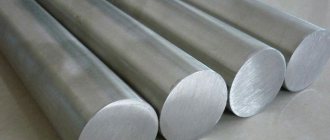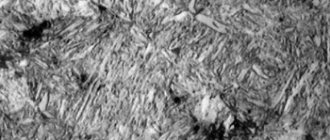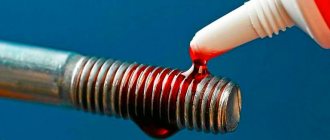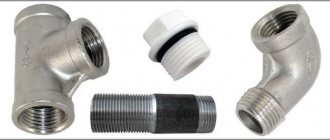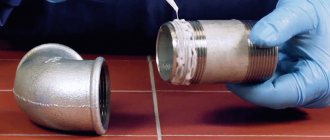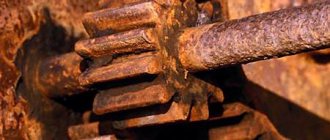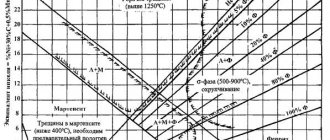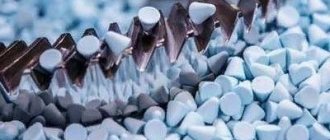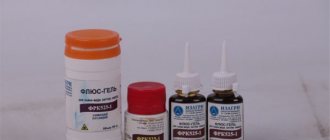This paste is used to remove some harmful effects from the high-temperature effects of a welding machine, or from mechanical processing (when tarnish or scale appears).
This paste is also used to restore the passive layer on steel (acid-resistant and stainless steel), where there is a warm effect.
Using this paste you can remove some contaminants that negatively affect the anti-corrosion barrier. The etching paste does not contain chlorides or hydrochloric acid.
Reaction time:
- The paste acts on copper-nickel alloys from 5 to 20 minutes;
The paste acts on acid-resistant and stainless steels from 15 to 1 hour;
Etching paste consumption:
Two kilograms of etching paste can process from 90 to 120 linear meters of weld.
How to use etching paste:
The paste is applied to a surface that has been previously cleaned of various contaminants and degreased, and all this is left for some time. After the surface has been treated, everything is thoroughly washed off with enough water. Using Antox HP or alkaline products, the surface is neutralized.
Some important points
- When the processing process occurs, it is necessary to use two main tools: a spatula (made of plastic material) - in order to remove the etching paste from its container, and a brush (it is recommended to use an acid-resistant one) to apply the etching paste to the desired surface.
- If these tools are not used, oxides on the surface being treated may enter the container, and this will subsequently reduce the chemical reactivity of the substance the next time it is used.
- The storage temperature of the etching paste should be from +5 to +30 degrees Celsius. If the product is exposed to sub-zero temperatures, it will lose all its properties. The substance should be stored in a thoroughly ventilated area. The jars containing the paste must be tightly closed.
- When the processing process takes place, some basic rules must be observed: the work must be done in a sufficiently ventilated area, and the worker must wear gloves and special safety glasses.
Etching pastes and sprays for stainless steel
| Etching pastes are used for partial processing of welds, spot welds, bends, etc. This etching process removes oxides, foreign metals, hard deposits and discoloration. |
| Special paste for simultaneous pickling and polishing of stainless steel |
| Etching spray is used in jet etching to treat large surface areas. |
| Pickling Bath - Dip pickling of stainless steel is the best method for obtaining a chemically clean, uniform surface as the temperature of the bath can be adjusted and controlled. |
Methods for processing stainless steel
A number of methods have been developed for processing stainless steel to give products the required parameters and aesthetic appearance. The following methods can be used at home:
- pickling of stainless steel;
- painting;
- satin finishing (grinding and polishing);
- bluing;
- chrome plating
Stainless steel pickling procedure
The main way to clean the surface of stainless steel is etching (chemical and electrochemical). This method is used after heat treatment of the product, cold and hot plastic deformation, and also to remove weld marks. In addition to cleaning the surface, etching stainless steel restores the passive layer that protects the stainless alloy from the damaging effects of high temperatures.
Etching a stainless steel product using acid
The method is based on the chemical interaction of the metal surface with acids of varying degrees of concentration, mainly sulfuric or hydrochloric, and molten alkaline compounds. The use of acids involves a two-step process: first, treatment with a sulfuric acid solution, then placement in a nitric acid environment. When using the alkaline method, a caustic soda solution is used.
When processing stainless steel, careful control over compliance with technological conditions is necessary. The aggressive environment in which the metal is placed should only affect its surface, destroying defects without changing the structure of the object itself. To prevent overetching, special additives are used.
Electrochemical (galvanic) etching
To carry it out, it is necessary to perform a number of procedures.
Preparation of the solution . Prepare an aqueous solution of the acid chosen for etching. It is necessary to carefully calculate its percentage.
Scheme for producing probes using electrochemical etching
Surface preparation. It is necessary to perform degreasing using any method so that the protective varnish adheres well to the stainless steel. After processing, it is not recommended to touch the workpiece so as not to cause peeling of the varnish and, as a result, uneven surface treatment.
Creation of a protective layer . It is necessary to apply a protective layer to areas that do not need etching. In industry, special compounds are used for this, which can also be used for home processing (subject to safety precautions). You can also cook a protective varnish at home, consisting of tar and rosin dissolved in turpentine.
Etching . When carrying out electrochemical etching of stainless steel, the workpiece is lowered into a previously prepared solution, after which voltage is applied to the created electrical circuit. In this circuit, the anode is a workpiece with a connected positive electrode; any steel plate is used as a cathode.
The duration is determined by the type of part, carefully observing the condition of the workpiece, but not more than a few minutes. After this, turn off the voltage, remove the etched part from the solution and carefully neutralize the acid using reagents.
Cleaning stainless steel . Clean stainless steel from residual solutions using special means that do not affect the characteristics of the metal.
Chemical etching
It is based only on chemical reactions, without additional exposure to electric current. For etching stainless steel at home, specially developed compositions are used - etching pastes. They are safer than reagents used in industrial settings. These pastes do not contain hydrochloric acid (due to increased health risks).
Result after chemical etching
Homemade formulations differ from industrial substances in their reduced content of harmful chlorides. Pastes are made on the basis of nitric and hydrofluoric acid. This is a liquid, jelly-like, transparent substance that requires caution when used.
Before using the paste, the stainless alloy workpiece must be thoroughly cleaned and degreased. To apply the paste to stainless steel, special tools are used: plastic spatulas and brushes made of acid-resistant materials.
The holding time of the paste depends on the brand used; it is indicated in the instructions for the paste. Possible time interval – from 10 minutes. up to an hour. The paste is washed off with plenty of running water (taking precautions).
When working with large products, the large area of which makes applying pastes difficult, use the jet spraying method using etching sprays for processing stainless steel.
Etching spray for stainless steel
Measures to prevent seizing of threaded connections
An effective solution for preventing damage to stainless steel fasteners during installation are EFELE pastes containing solid lubricants - highly dispersed graphite powder, molybdenum disulfide, copper powder, and special fillers. An optimally selected ratio of components makes it possible to achieve their synergistic interaction and obtain high performance properties of the composition at the lowest cost.
EFELE thread pastes are applied to the threaded and end surfaces of the element by spraying from an aerosol can or with a brush.
Due to the high content of solid lubricants in the pastes (up to 60%), an effective separating layer is formed between the contacting metal surfaces, withstanding significant loads and protecting the connection parts from direct contact and seizure.
The depressions of micro-irregularities in the relief are filled with highly dispersed particles of graphite, copper or special compositions, which leads to an increase in the supporting area and bearing capacity of the surface. Thanks to the layered structure of solid particles, EFELE pastes have unique anti-friction characteristics. The use of these lubricants reduces and stabilizes friction, thereby ensuring high-quality tightening of the threaded connection.
The solid lubricants included in EFELE pastes are characterized by chemical inertness, thermal and oxidative stability. Even after a long period of inactivity of the unit under the influence of aggressive environmental factors, they provide the ability to disassemble the threaded connection using conventional tools.
Resistant to washout and aggressive environmental influences, thread paste EFELE MP - 491 ensures controlled tightening of stainless steel threaded connections without damage with a precisely specified very high torque. Typical examples of its application are threaded connections of centrifugal separators in the food industry, installation of flange connections for pipelines for various purposes. The paste allows you to ensure uniform tightening of all connection bolts and prevent joint deformation.
Thanks to the special purity of the components, EFELE thread paste MP - 413 is compatible with heat-resistant steels, reduces the risk of intergranular corrosion and is the optimal solution for threaded connections exposed to high temperatures. EFELE MP - 413 is widely used in metallurgy, energy, the oil and gas industry, and the chemical industry for threaded connections of gate valves, steam and gas turbines, drill pipes, geophysical equipment, and pumps.
Pickling agents
From the large number of etching pastes produced, the most popular brands can be identified.
Avesta Blue On e (Sweden) . Reliable Swedish-made etching paste Avesta BlueOne. Removes corrosion, minor welding defects, and adds shine to products. Processing time depends on the ambient temperature: from 90 minutes. at 100°C for up to 20 minutes. at 300°C. The etching time for stainless steel depends on the condition of the surface.
SAROX TS-K 2000 (Czech Republic) . Cleans stainless steel from scale and other defects, providing a beautiful appearance of the weld seam. Due to its high density, the gel-like paste is effective even for vertical surfaces. Processing time is 10 minutes.
Stain Clean from ESAB (Sweden ) . A high-quality brand that restores the anti-corrosion properties of stainless alloys. Does not require stirring. Can be used on vertical surfaces. It has a low content of harmful nitrogen gases. Not applicable at temperatures below +5°C.
Post-weld agent for pickling welds Deoxyl-1 gel
- Description
- Advantages
- Application
- Photos
- How to buy?
- Responsibility
A product for removing carbon deposits after welding is the best domestic development
In terms of its performance indicators, the gel for weld passivation is not inferior to the best foreign analogues, and in some respects it surpasses them. The post-weld product ensures high cleanliness and excellent appearance of the seam. The composition was recognized as the best Russian development in 2012! To this day it has no analogues on the domestic market.
Chemical etching of welds
The weld passivation agent is a gel-like composition based on a complex of surfactants with an acid component and corrosion inhibitors. Chemical etching actively removes rust, oxide films, traces of tarnish, lime and mineral deposits, with a simultaneous degreasing effect. There is no gas emission. Fireproof. Product consumption after welding is 100-150 g/m² for manual processing.
- Low price;
- good adhesion; no gas emission;
- ease of use;
- short etching time (5-15 min.);
- high thixotropy (does not roll or flow after application to a vertical surface);
- Possibility of use in a wide temperature range
- (from -5 to + 40 degrees C);
- frost resistance (the paste does not freeze and does not lose its properties even at -15 degrees C);
- no clumping during storage (shelf life 2 years);
Scope of application of chemical etching, passivation of welds:
- Construction, mechanical engineering, shipbuilding, aircraft manufacturing, auto repair, railway, metro and their Depots:
- removal of oxide films from surfaces of ferrous and non-ferrous metals with a simultaneous degreasing effect for preparation for paint, galvanic, and powder coating;
- surface cleaning of internal combustion engines from rust;
- washing of the machine park;
- etching from surface rust;
- removal and transformation of rust on the surface of reinforcement and elements of reinforced concrete structures during concreting and painting;
When etching, the paste not only removes possible sources of corrosion, but also cleans the seams. The result is a smooth, matte finish with clean welds and high corrosion resistance.
"Desoxyl" 1 Gel is supplied as a finished product with a jelly-like consistency. Shake canister vigorously before use.
- Apply the paste with a regular brush to the seam in a layer of 2-3 mm. The treatment is carried out manually, by applying a thin layer of gel along the seam and scale, using a brush, roller and other tools, by pouring, dipping and holding for 3 to 20 minutes.
- Pour the required amount of paste into a regular plastic spray bottle or pump sprayer. Apply the gel to a dry stainless steel surface and leave for 10-20 minutes.
Other processing methods
Alternative methods can also be used for finishing stainless steel products.
Painting
The most affordable and easy-to-implement method that allows you to quickly create a protective film.
Powder painting
Satin finishing (polishing and grinding)
This method of processing stainless steel combines practicality and efficiency. After treatment, the stainless steel surface acquires the smoothness of satin. At home, small-sized tools are used for grinding stainless steel: a grinding machine, a pneumatic file, etc. Small areas are satin-finished manually, using sanding sheets or a manual machine. To obtain a high-quality result, grinding begins with the use of 180 grit sheets, then switches to 320, 600 grit. Finally, polish with felt.
Bluing (blackening)
The surface of stainless steel is covered with a protective oxide film of blue-black color. Three methods of film creation are used: acidic, alkaline and thermal. The latter method is available only in industrial conditions, when stainless steel is treated at temperatures from 250 to 8500C in one of three ways:
- in melted salts;
- in a vapor solution of alcohol and ammonia;
- in superheated steam.
In everyday life, stainless steel is blackened in solutions of acids or alkalis using an electrochemical or chemical method.
Cold blackening scheme
Chrome plating
This method of processing stainless steel reliably protects the surface of products from mechanical and other damage. But its implementation requires knowledge of technology and work experience. Therefore, chrome plating is practically not used at home.
Scheme of jet chrome plating of steel
Related video: Metal etching at home
Useful articles
How to determine the price of 1 kg of stainless steel scrap
Secrets of nickel plating metal objects at home
The process of chrome plating metal products at home
Paste - cleaning, etching, removal
Paste - Used for removing (cleaning, etching, removing) oxide stains, so-called tarnish, formed during welding of stainless and acid-resistant steels.
A useful thing but expensive 1 kg. about 1000 rub.
I would like to have a cheaper analogue. Here's one recipe I found:
The invention relates to the field of chemical cleaning of metal surfaces and can be used to remove scale and rust from welds of stainless steel products, as well as to give them a decorative appearance.
During high-temperature heat treatment of stainless chromium-nickel steel products, for example by welding, oxidation of the steel surface occurs. This is a consequence of a change in the composition of the metal due to the depletion of the protective surface film of Cr2O3 in chromium and the release of iron to the surface, as a result of which the steel loses its corrosion resistance. This results in discoloration, darkening or corrosion of welds.
This problem is solved by chemical etching of steel with special pastes, which are a mixture of acids with the addition of an inert filler or thickener, which remove rust from the seams, passivate the surface of the steel, and also ensure a uniform appearance of the product.
A known composition for removing rust from metal surfaces (patent EP 0233110, C 23 G 1/02), containing an acid solution of formic, acetic and citric acids and a thickener, which is a polysaccharide. To obtain the polysaccharide, natural or biosynthetic rubber, as well as a mixture of them, is used.
However, this composition uses weak organic acids, for which the reaction rate with the metal is low, as a result of which the processing process requires a significant amount of time. The use of rubber as a thickener also reduces the effectiveness of the treatment.
A known paste for removing scale from the surface of stainless steel (A.S. USSR 514913, C 23 G 1/04, 1973), containing a mixture of nitric, hydrochloric, hydrofluoric, salicylic acids and hydrogen peroxide, and a mixture of fireclay as an inert filler , quartz sand, cullet, kaolin and aluminum oxide. The disadvantages of this composition are:
— multicomponent and complexity of its preparation;
— high acidity (more than 800 g of strong acids per 1 liter of paste), which requires increased safety measures;
- use of solid mineral additives as a binder, the particles of which shield active substances from the surface being treated, which significantly reduces the efficiency of using reagents. For the same reason, good wetting of the steel surface with the paste is not ensured, which makes it difficult to remove scale from seams in hard-to-reach areas of the product;
— difficult cleaning of the steel surface from paste after processing.
The essence of the invention lies in the fact that the paste for treating the surface of stainless steel contains a mixture of nitric acid with a fluorine compound, a binder and water.
According to the invention, ammonium fluoride is used as a fluoride compound, and dextrins, obtained, for example, by thermolysis of starch, are introduced as a binder in the following component ratio, g/l:
Nitric acid (d = 1.4) – 250 – 350
Ammonium fluoride – 75-108
Dextrin – 250 – 350
Water - 350-500
The technical result obtained by implementing the invention is to reduce the components in the paste, increase the efficiency of the use of reagents, increase labor safety, improve wettability, and also simplify the removal of the paste from the surface being treated.
The specified technical result is achieved due to the combination of distinctive features of the patented invention:
the use of dextrins as a binder (thickener) as a gel-forming component makes it possible to increase the efficiency of using reagents, since the acid mixture, in the absence of mechanical inclusions, diffuses unhindered to the metal surface. In addition, since the acid is completely consumed during the reaction, the spent composition does not contain it. The gel-like paste has good wettability and is easily applied to any surface of the product - internal and corner seams, the root of the seam when butt welding. The use of a fluoride salt in the paste reduces its acidity and increases the safety of the composition. After treatment, the paste is easily washed off with water. The use of dextrins obtained by thermolysis of starch as a binder ensures the purity of the thickener and its greater inertness in the ongoing reaction compared to dextrins obtained industrially, the alkaline components of which can partially neutralize the acid of the paste.
Example 1. Place 215 g of nitric acid in a plastic container, add 90 g of ammonium fluoride and stir with a plastic stick until completely dissolved. Then dextrins are added to the resulting solution as a thickener in an amount of 320 g and 450 ml of water is added. The resulting mass is thoroughly stirred for 5 hours at room temperature.
Example 2. 336 g of nitric acid and 98 g of ammonium fluoride are placed in a plastic container and stirred with a plastic stick until completely dissolved. Then, dextrins obtained by thermolysis of starch are added to the resulting solution as a thickener in an amount of 720 g. The resulting mass is thoroughly stirred for 5 hours at room temperature. To prepare dextrins, 320 g of starch is poured into 400 ml of water and heated with constant stirring to a boil, kept at boiling temperature for 2 minutes, and then cooled to room temperature. The resulting mass is crushed using a stainless steel cutting tool.
The processing is carried out on a product made of stainless steel grade 12Х18Н10Т with a thickness of 0.5 to 10 mm, welded by manual argon arc welding, on the surface of the weld which scale has formed, and tarnished colors have appeared on the metal exposed to high temperature. The paste prepared in the above manner is applied to the surface of the oxidized metal with a layer of 1 - 3 mm. As a result of treatment with the paste for 30 - 50 minutes at room temperature, the surface acquires the color of unoxidized metal, the resulting oxides are completely removed and a passivated surface is formed. The paste is removed with a stream of water under low pressure or with a damp cloth, then the surface is washed with water.
The use of this paste makes it possible to quickly and effectively remove products formed when welding stainless steel in an argon environment. The paste is easy to make, does not flow from any surface of the processed product, gives it a decorative presentation, and is also safer to use. Cleaning with a paste of this composition can be used in the manufacture and installation of stainless steel equipment intended for operation in corrosive environments, as well as in the manufacture of vacuum equipment.
Formula of invention: 1. Paste for treating the surface of stainless steel, containing a mixture of nitric acid with a fluorine compound, a binder and water, characterized in that ammonium fluoride is used as a fluoride compound, and dextrins are used as a binder, with the following component ratio, g/ l:
Nitric acid (d =1.4) – 250 – 350
Ammonium fluoride – 75 – 108
Dextrin – 250 – 350
Water – 350 – 500
2. Paste according to claim 1, characterized in that dextrins obtained by thermolysis of starch are used as a binder.
Maybe someone is already using something like this?
